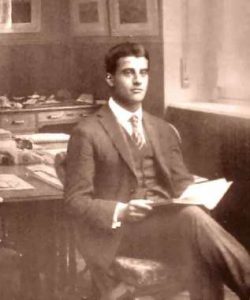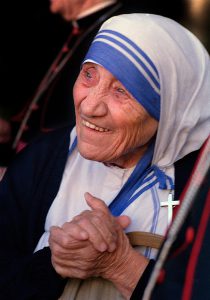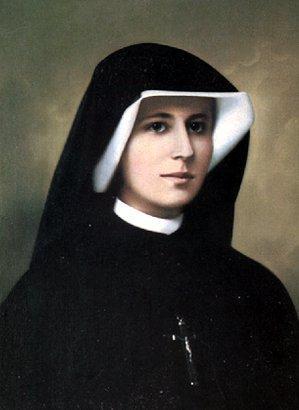
By Renae Kranz
When I decided to write this month’s post about St. Maria Faustina Kowalska, it was originally because it would be posted just before Holy Week and the beginning of the Divine Mercy Novena which starts on Good Friday. But God, as is His way sometimes, had more in mind.
As I write this, we are in the midst of the 2020 coronavirus pandemic in the U.S. Most of the country is staying home. Schools are closed. Events are cancelled. The world is at a standstill.
Worst of all, public Masses are not available to the faithful. So many things are unknown right now. We’re trying to hold it together, but we may feel fear and helplessness in a way we’ve never experienced.
It’s the perfect time to look more deeply at a saint who felt all those things and suffered privately for the glory of God. St. Maria Faustina is a saint we can look to for help during these troubling times.
Born Helena Kowalska on August 25, 1905, in Glogowiec, Poland (near Lódz), Maria was the third of 10 children. Her parents, Stanislaw and Marianna, were poor peasants who raised a religious family. At the age of only 7, she first felt the call to religious life during the exposition of the Blessed Sacrament.
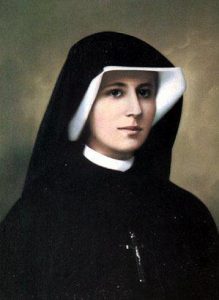 After completing her brief schooling (only three years), Maria asked her parents for their permission to enter a convent. They refused to give their permission because they needed her to work to help support the struggling family. So instead of following her call to the convent, she went to work as a housekeeper at 16, moving around to several cities.
After completing her brief schooling (only three years), Maria asked her parents for their permission to enter a convent. They refused to give their permission because they needed her to work to help support the struggling family. So instead of following her call to the convent, she went to work as a housekeeper at 16, moving around to several cities.
Maria didn’t take the refusal of her parents regarding entering a convent well. In her diaries, later published in a book “Divine Mercy in My Soul,” she admitted she “turned herself over to the vain things of life, paying no attention to the call of grace, although my soul found no satisfaction in any of these things. The incessant call of grace caused me much anguish; I tried, however, to stifle it with amusements. Interiorly, I shunned God, turning with all my heart to creatures. However, God’s grace won out in my soul.”
Just like the rest of us, she felt the desire to rebel and did rebel, even after the Lord invited her to a more perfect life. Original sin has a hold on all of us. But all hope is not lost.
In 1924 at 19 years old, Maria had a vision of Jesus for the first time. She was with her sister Natalia at a dance in a park in Lódz. While there, the Lord spoke to her as everyone else was dancing and enjoying themselves. He was covered in wounds and in great pain and asked her, “How long will you keep putting me off?” Maria was experiencing deep torment in her soul.
She retreated to the cathedral nearby where Christ told her to leave for Warsaw immediately and join a convent. She went home, told only her sister about her vision at the park, and left for Warsaw with nothing more than the dress she had on and without permission from her parents.
Once in Warsaw, she was very afraid as you can imagine. She didn’t know what she was supposed to do now that she was there. She had just left everything and everyone she knew and had no plan. Because of her devotion to the Blessed Mother, Maria asked Mary to lead her. She heard a voice telling her to go to a nearby village and where to find safe lodging. Everything was as Mary had told her.
She went to the first church she came across (St. James Church) and attended Mass. When Maria asked the priest of that parish for his advice about what to do next, he sent her to a trusted local woman who could help her. She stayed with her until she found her convent home.
Finding a convent that would accept her proved to be much harder than Maria imagined. She was denied over and over, sometimes because she was too poor. In her diary, she expressed great sorrow that so many convents denied her. She felt frustrated and walked on the edge of hopelessness.
Finally one convent gave her a chance. The mother superior at the Congregation of the Sisters of Our Lady of Mercy agreed to accept her, on the condition she pay for her own habit. She worked for a year as a housemaid, and on April 30, 1926, received her habit and took her religious name, Sister Maria Faustina of the Blessed Sacrament. The name “Faustina” means fortunate or lucky.
Maria took her first vows in April 1928 at 22 years old. Her parents were present to see their daughter finally complete her first calling.
Over the next 10 years, Maria had many visions of the Lord and Mary. She also dreamed of St. Therese of the Child Jesus (St. Therese of Lisieux) and described that dream in her diary.
“I was still a novice at the time and was going through some difficulties which I did not know how to overcome. The sufferings it caused me were so great that I did not know how to go on living, but suddenly the thought occurred to me that I should pray to St. Therese of the Child Jesus…I started a novena and began to pray with great fervor.”
When Maria dreamed of St. Therese on the fifth day of the novena, she told Maria to trust more in God rather than worrying about her difficulties. This is good advice for all of us, especially now. I know, easier said than done.
Maria also often had doubts about the visions she saw and what the Lord was asking her to do. Many times He had to come to her at least twice before she would let go of her doubts and do what He asked of her.
After being sent to convents in several cities, she was transferred to the convent in Plock, Poland, in May 1930. It is here Jesus revealed to Maria her most important calling—telling the world about His Divine Mercy.
In her diary, Maria described a vision she had on February 22, 1931, while in her room. She saw Jesus before her, clothed in a white garment, with red and pale rays flowing out from His heart. His left hand is touching his garment where the rays originate and his right hand is raised in a blessing. Jesus said to her:
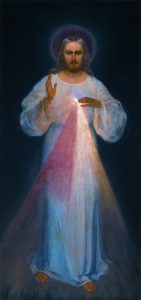 “Paint an image according to the pattern you see, with the signature: ‘Jesus, I trust in You.’ I desire that this image be venerated, first in your chapel, and then throughout the world. I promise that the soul that will venerate this image will not perish.”
“Paint an image according to the pattern you see, with the signature: ‘Jesus, I trust in You.’ I desire that this image be venerated, first in your chapel, and then throughout the world. I promise that the soul that will venerate this image will not perish.”
Maria now had a new mission: to spread the Lord’s message of trust and mercy. This would complete God’s school of trust. But as beautiful and joyful as this was, it was also frightening for her. In following visions He also told her to write diaries about her visions and life. This weighed heavily on Maria.
“When I became aware of God’s great plans for me, I was frightened at their greatness and felt myself quite incapable of fulfilling them, and I began to avoid interior conversations with Him, filling up the time with vocal prayer. I did this out of humility, but I soon recognized it was not true humility, but rather a great temptation from the devil. When on one occasion, instead of interior prayer, I took up a book on spiritual reading, I heard these words spoken distinctly and forcefully within my soul. ‘You will prepare the world for my final coming.’ These words moved me deeply, and although I pretended not to hear them, I understood them very well…”
Strangely enough I can relate to what Maria describes here. I haven’t had visions of Jesus, but the Church’s call to us to be holy and fulfill our own calling in life can often feel frightening and impossible. Many times I feel completely incapable of doing what I feel the Lord calling me to. Even writing these blog posts weighs heavily on me some days.
When I feel that heavy weight, I sometimes do what Maria did—avoid the problem by putting off writing and pretending there is no problem. But every time I do that, I find myself eventually heading to the cathedral and asking the Lord to help me release my fear and let the words come out as He wants them to.
We can do that in every area where fear and doubt pop up in our lives. We can hand them over to Jesus and surrender to His love for us. We can let His will be done instead of fighting against it, even with what appear to be good intentions or as Maria realized, false humility.
Jesus may not visit us as a vision as He did Maria, but He is working in our lives. If we seek Him, we will find Him and cooperate with Him.
A couple years later, Maria was transferred to the convent in Vilnius and met her spiritual director there, Father Michael Sopocko. After telling him about her conversations with Jesus at her first confession with him, he had her complete a psychiatric evaluation. After seeing Maria pass the test declaring her sanity, Father Sopocko began to believe she was truly seeing what she claimed.
With Father Sopocko’s help, Maria found someone to paint the Divine Mercy image the Lord asked her to create. That first image was painted by artist Eugene Kazimierowski in 1934. The first Mass celebrated with the Divine Mercy image displayed was April 28, 1935, the first Sunday after Easter that year, which fulfilled subsequent requests made by Jesus in visions revealed to Maria.
Over the next few years before her death, Maria wrote the Chaplet of Divine Mercy and described many additional visions and conversations with Jesus in her diaries. She laid out the purpose of the chaplet’s prayers for mercy: to obtain mercy, to trust in Christ’s mercy, and to show mercy to others.
Father Sopocko printed brochures and holy cards about the Divine Mercy devotion and helped to spread it eventually around the world. Its message reached the U.S. by 1941 and millions of the prayer cards were printed and distributed worldwide.
The last two years of St. Maria Faustina’s life were spent praying and writing in her diary. She suffered from tuberculosis and died at the age of 33 on October 5, 1938, in Krakow.
Saint John Paul II had a great devotion to the Divine Mercy even before he became pope. He initiated the informative process into Maria’s life to pave the way for sainthood in 1965 while he was the Archbishop of Krakow. As pope, he beatified St. Maria Faustina on April 18, 1993, canonized her on April 30, 2000, and established the first Sunday after Easter as Divine Mercy Sunday. She is the patron of mercy.
A final beautiful word from St. Faustina, just because I can’t get enough of them.
“I feel certain that my mission will not come to an end upon my death, but will begin. O doubting souls, I will draw aside for you the veils of heaven to convince you of God’s goodness, so that you will no longer continue to wound with your distrust the sweetest heart of Jesus. God is love and Mercy.”
Get the latest "Can We Be Saints?" post in your inbox!
[jetpack_subscription_form title=”” subscribe_text=”Signup to be notified of the Saint’s Blog updates” subscribe_button=”Sign Up for Saints”]

